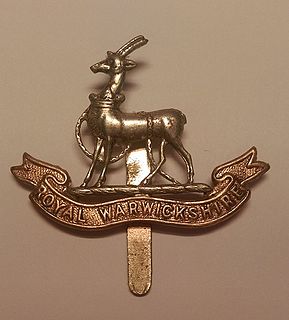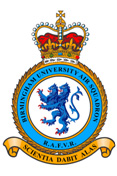 W
WThe South Midland (Warwickshire) Royal Garrison Artillery was a volunteer artillery unit of Britain's Territorial Force formed in 1908. It served in Home Defence and provided heavy artillery support to the armies on the Western Front and Italian Front in World War I. In the interwar years it became 204 (Warwickshire) Battery serving in various regiments and formations before being expanded into a full regiment. In World War II it served in the heavy anti-aircraft (HAA) role defending its home area of the West Midlands against German air attack, and then defended Calcutta against Japanese attacks. It continued in the postwar Territorial Army until 1955.
 W
WThe 4th (Volunteer) Battalion, The Worcestershire and Sherwood Foresters was a former territorial infantry battalion that existed for a short time towards the end of the Cold War. Following reductions to the Territorial Army (TA) in 1992, the battalion was disbanded with elements helping to form RHQ & HQ Sqn of 37 Signal Regiment, and 96 Signal Squadron. This squadron was then reduced to a signal troop in 2009, but continues to exist as part of 48 Signal Squadron.
 W
WThe Royal Warwickshire Regiment, previously titled the 6th Regiment of Foot, was a line infantry regiment of the British Army in continuous existence for 283 years. The regiment saw service in many conflicts and wars, including the Second Boer War and both the First and Second World Wars. On 1 May 1963, the regiment was re-titled, for the final time, as the Royal Warwickshire Fusiliers and became part of the Fusilier Brigade.
 W
WThe 6th Battalion, Royal Warwickshire Regiment was a unit of Britain's Territorial Army (TA) from 1908 until 1961. Recruited from Birmingham, it served as infantry in some of the bloodiest fighting on the Western Front and in Italy during World War I. Converted to an Anti-Aircraft (AA) role, it defended the West Midlands during The Blitz in the early part of World War II, and then joined Eighth Army in North Africa, including service in the famous Siege of Tobruk and in the Italian Campaign. It served on in the air defence role in the postwar TA until 1961.
 W
W56th (Cornwall) Heavy Anti-Aircraft Regiment, Royal Artillery was a volunteer air defence regiment of Britain's Territorial Army (TA). Originally raised in 1920 as a medium artillery regiment, it was converted to the anti-aircraft role in 1932. During the Second World War, it was employed in Home Defence, in Iceland and then in India, where it was temporarily converted back to medium artillery. Postwar, it reverted to air defence until disbandment in 1955.
 W
WThe South Wales Borderers was a line infantry regiment of the British Army in existence for 280 years.
 W
W56th (Cornwall) Heavy Anti-Aircraft Regiment, Royal Artillery was a volunteer air defence regiment of Britain's Territorial Army (TA). Originally raised in 1920 as a medium artillery regiment, it was converted to the anti-aircraft role in 1932. During the Second World War, it was employed in Home Defence, in Iceland and then in India, where it was temporarily converted back to medium artillery. Postwar, it reverted to air defence until disbandment in 1955.
 W
WThe 59th (Warwickshire) Searchlight Regiment, Royal Artillery was an air defence unit of the Territorial Army (TA), part of the British Army, and was raised in Birmingham in 1938 just before the Second World War. It later served as a light anti-aircraft gun unit and continued in the postwar TA.
 W
WThe 6th Battalion, Royal Warwickshire Regiment was a unit of Britain's Territorial Army (TA) from 1908 until 1961. Recruited from Birmingham, it served as infantry in some of the bloodiest fighting on the Western Front and in Italy during World War I. Converted to an Anti-Aircraft (AA) role, it defended the West Midlands during The Blitz in the early part of World War II, and then joined Eighth Army in North Africa, including service in the famous Siege of Tobruk and in the Italian Campaign. It served on in the air defence role in the postwar TA until 1961.
 W
WThe South Midland (Warwickshire) Royal Garrison Artillery was a volunteer artillery unit of Britain's Territorial Force formed in 1908. It served in Home Defence and provided heavy artillery support to the armies on the Western Front and Italian Front in World War I. In the interwar years it became 204 (Warwickshire) Battery serving in various regiments and formations before being expanded into a full regiment. In World War II it served in the heavy anti-aircraft (HAA) role defending its home area of the West Midlands against German air attack, and then defended Calcutta against Japanese attacks. It continued in the postwar Territorial Army until 1955.
 W
WThe 4th (Volunteer) Battalion, The Worcestershire and Sherwood Foresters was a former territorial infantry battalion that existed for a short time towards the end of the Cold War. Following reductions to the Territorial Army (TA) in 1992, the battalion was disbanded with elements helping to form RHQ & HQ Sqn of 37 Signal Regiment, and 96 Signal Squadron. This squadron was then reduced to a signal troop in 2009, but continues to exist as part of 48 Signal Squadron.
 W
WThe 59th (Warwickshire) Searchlight Regiment, Royal Artillery was an air defence unit of the Territorial Army (TA), part of the British Army, and was raised in Birmingham in 1938 just before the Second World War. It later served as a light anti-aircraft gun unit and continued in the postwar TA.
 W
W190th Heavy Anti-Aircraft Battery, Royal Artillery, was an air defence unit of Britain's Territorial Army formed in Birmingham before World War II. It defended the West Midlands against attack during the Battle of Britain and the early part of the Blitz, and was then shipped to Malta, where it served through most of the long siege when the island fortress was bombed incessantly.
 W
W191st Heavy Anti-Aircraft Battery, Royal Artillery, was an air defence unit of Britain's Territorial Army formed in Birmingham before World War II. It defended the West Midlands against attack during the Battle of Britain, and was then shipped to Malta, where it served through most of the long siege when the island fortress was bombed incessantly.
 W
WThe South Midland (Warwickshire) Royal Garrison Artillery was a volunteer artillery unit of Britain's Territorial Force formed in 1908. It served in Home Defence and provided heavy artillery support to the armies on the Western Front and Italian Front in World War I. In the interwar years it became 204 (Warwickshire) Battery serving in various regiments and formations before being expanded into a full regiment. In World War II it served in the heavy anti-aircraft (HAA) role defending its home area of the West Midlands against German air attack, and then defended Calcutta against Japanese attacks. It continued in the postwar Territorial Army until 1955.
 W
WThe 6th Battalion, Royal Warwickshire Regiment was a unit of Britain's Territorial Army (TA) from 1908 until 1961. Recruited from Birmingham, it served as infantry in some of the bloodiest fighting on the Western Front and in Italy during World War I. Converted to an Anti-Aircraft (AA) role, it defended the West Midlands during The Blitz in the early part of World War II, and then joined Eighth Army in North Africa, including service in the famous Siege of Tobruk and in the Italian Campaign. It served on in the air defence role in the postwar TA until 1961.
 W
WThe South Midland (Warwickshire) Royal Garrison Artillery was a volunteer artillery unit of Britain's Territorial Force formed in 1908. It served in Home Defence and provided heavy artillery support to the armies on the Western Front and Italian Front in World War I. In the interwar years it became 204 (Warwickshire) Battery serving in various regiments and formations before being expanded into a full regiment. In World War II it served in the heavy anti-aircraft (HAA) role defending its home area of the West Midlands against German air attack, and then defended Calcutta against Japanese attacks. It continued in the postwar Territorial Army until 1955.
 W
WThe 59th (Warwickshire) Searchlight Regiment, Royal Artillery was an air defence unit of the Territorial Army (TA), part of the British Army, and was raised in Birmingham in 1938 just before the Second World War. It later served as a light anti-aircraft gun unit and continued in the postwar TA.
 W
WThe 4th (Volunteer) Battalion, The Worcestershire and Sherwood Foresters was a former territorial infantry battalion that existed for a short time towards the end of the Cold War. Following reductions to the Territorial Army (TA) in 1992, the battalion was disbanded with elements helping to form RHQ & HQ Sqn of 37 Signal Regiment, and 96 Signal Squadron. This squadron was then reduced to a signal troop in 2009, but continues to exist as part of 48 Signal Squadron.
 W
WThe Queen's Own Warwickshire and Worcestershire Yeomanry was a regiment of the Royal Armoured Corps, forming part of the Territorial Army (TA). Following reductions in 1969 and 1971 respectively the regiment was reduced to two and later one company sized sub-units in 1999. Following a reorganisation in 2021, there are now two sub-unit successors to the regiment.
 W
WThe Royal Warwickshire Regiment, previously titled the 6th Regiment of Foot, was a line infantry regiment of the British Army in continuous existence for 283 years. The regiment saw service in many conflicts and wars, including the Second Boer War and both the First and Second World Wars. On 1 May 1963, the regiment was re-titled, for the final time, as the Royal Warwickshire Fusiliers and became part of the Fusilier Brigade.
 W
WThe Royal Warwickshire Regiment, previously titled the 6th Regiment of Foot, was a line infantry regiment of the British Army in continuous existence for 283 years. The regiment saw service in many conflicts and wars, including the Second Boer War and both the First and Second World Wars. On 1 May 1963, the regiment was re-titled, for the final time, as the Royal Warwickshire Fusiliers and became part of the Fusilier Brigade.
 W
WThe South Midland (Warwickshire) Royal Garrison Artillery was a volunteer artillery unit of Britain's Territorial Force formed in 1908. It served in Home Defence and provided heavy artillery support to the armies on the Western Front and Italian Front in World War I. In the interwar years it became 204 (Warwickshire) Battery serving in various regiments and formations before being expanded into a full regiment. In World War II it served in the heavy anti-aircraft (HAA) role defending its home area of the West Midlands against German air attack, and then defended Calcutta against Japanese attacks. It continued in the postwar Territorial Army until 1955.
 W
WThe University of Birmingham Air Squadron, commonly known as UBAS, is a squadron within the Royal Air Force established in 1942. It is based at RAF Cosford, Shropshire, and flies a fleet of six Grob Tutors. In 2009 the squadron upgraded the aircraft to the Grob Tutor EA which has an advanced avionics suite. The Squadron has four Flights, A, B, C and D; each with a student Flight Commander who holds the rank of Acting Pilot Officer and a Deputy who holds the rank of Officer Cadet. UBAS is also the parent squadron of 8 Air Experience Flight, who jointly fly UBAS' Tutor fleet.